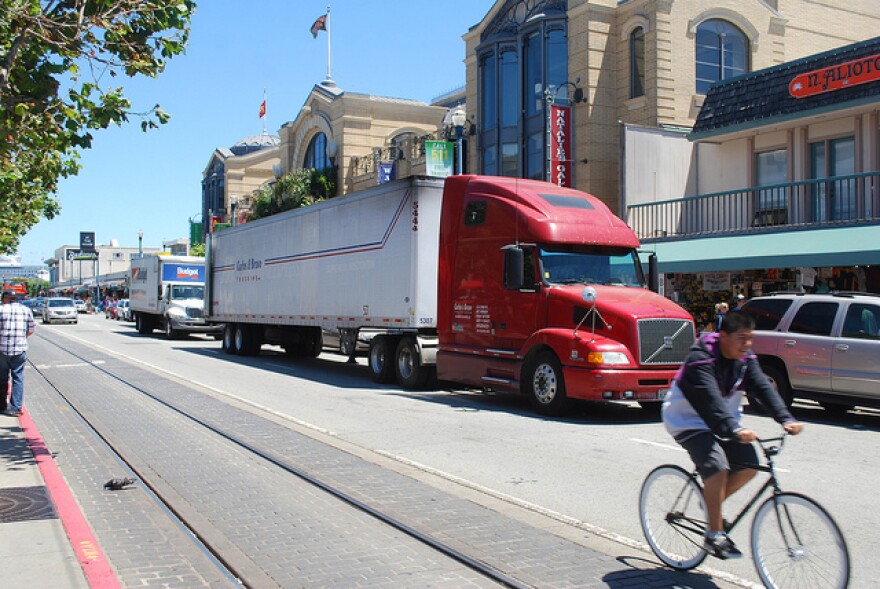We've all been there. Driving downtown during a high traffic time. Maybe on 9th Street. Listening to KBIA.
And then--stopped. There's a semi truck stopped in the lane up ahead.
The driver is delivering food or goods to a business next door. There's a parked car stuck next to the truck, and all the cars are merging into the oncoming traffic lane one at a time to get around the truck. Pedestrians idly walk through all the hustle. And you feel a little frustrated.
Is this even allowed?
The short answer here is no. Columbia City Code notes a few things that are relevant here:
"Sec. 14-298. - Leaving vehicle unattended with motor running.
No person shall leave a motor vehicle unattended or unattached on the street without first stopping the motor and cutting off the electric current.
Sec. 14-281. - Parking not to obstruct traffic.
No person shall park any vehicle upon a street, other than an alley, so as to create a clear and definite hazard or obstruction to the normal movement of traffic; however, this section shall not apply to any state highway as determined in section 14-61."
While these regulations don't particularly point to trucks or delivery vehicles, they could still apply. But deliveries are an essential part of the commerce in our city. Delivery trucks bring food and alcohol to our restaurants, goods to our stores, and packages to all. If we want those services we need delivery vehicles.

But if it isn't legal, why don't they get tickets?
Delivery vehicles and drivers can get tickets for driving in dangerous ways. But for the most part, enforcement of the above police with respect to delivery trucks is minimal. Police, delivery companies, and the downtown business owners know that deliveries are a vital part of business. If drivers were constantly ticketed, delivery companies would be upset. Besides, these entities recognize that in downtown Columbia, there isn't really another option.
What about back door and alley delivery?
The alleys in Columbia were built before semi-trucks existed. In most places, these alleys are only 15 to 16 feet wide. Semi-trucks need at least 18-20 feet to navigate through alleyways. Our city has grown and adapted to modern life faster than our infrastructure can adapt to it.
New construction can make room for more alley space, but it isn't required. The City of Columbia is aware of the problems our small alleys pose downtown, and has alley construction on the radar for the long, long, long, long term.
Is Columbia the only place with this problem?
No. Columbia is like many cities small and large all over the world that struggle with trucks in high population areas. Some towns in Europe don't even have streets wide enough to accommodate cars, let alone delivery vehicles. The dangers and inconveniences of delivery trucks downtown are felt worldwide. But, this also means there is a lot of interest in finding solutions.

What is Columbia doing to help?
The city, delivery companies, and downtown businesses have some guidelines in place to help trucks navigate safely through the district. A full list of guidelines can be found here. But the basics are as follows:
- small trucks and cars making deliveries should use alleys when possible
- large trucks should avoid high traffic times
- large trucks should make sure no more than one vehicle is double parked on each block, and use the same side of the road
- trucks can use the middle lane of Broadway Ave. to stop for deliveries
- all deliveries should be done as quickly as possible
What else could be done?
Some cities enforce strict times for deliveries of certain goods to late at night and early in the morning. But not all businesses are willing to pay staff to meet deliveries at times when the business is not normally open.
Some areas designate loading and unloading zones by taking away metered parking on city streets. Trucks can pull into the zone for deliveries without blocking traffic. This option is possible for a city like Columbia, but would limit street parking and parking revenue for the city.
Other creative solutions exist in other parts of the world. Aircrafts, like drones, are being experimented with for delivery of personal packages. Cyclists and smaller cars sometimes meet freight vehicles outside of city limits and then take goods into town in smaller loads. These options can create more cost for the delivery companies to pay extra drivers and provide more vehicles.
So while we wait for bicycle and drone delivery systems to make their way to CoMO, we might just have to sit behind a truck, and make our commute with a small appreciation for the many people with a stake in downtown deliveries.





